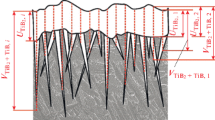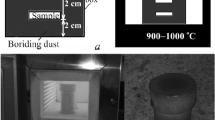Conclusions
-
1.
A study was made of the wear resistance and abrasive properties ofβ-B and transition metal borides in the microcutting of titanium and steel. It is shown that transition metal borides have good wear resistance in the grinding of titanium.
-
2.
β-B and transition metal borides are superior in abrasive power to corundum and carborundum abrasive materials, but are surpassed in this respect by synthetic diamond.
-
3.
In the grinding of VT1 titanium with tungsten boride abrasive wheels lower temperatures and smaller stresses are generated compared with wheels made of green silicon carbide and alumina.
Similar content being viewed by others
Literature cited
A. A. Matalin, Surface Quality and Operating Properties of Machine Components [in Russian], Mashgiz, Moscow-Leningrad (1956).
P. I. Yashcheritsyn, A. K. Tsokur, and M. L. Eremenko, Thermal Phenomena in Grinding and Properties of Ground Surfaces [in Russian], Nauka i Tekhnika, Minsk (1973).
I. M. Belosludtsev, Fiz. i Khim. Obrabotki Material., No. 5 (1972).
V. V. Stasovskaya, An Investigation into the Hardness, Brittleness, and Abrasive Powers [in Russian], Candidate's Dissertation, IPM AN UkrSSR, Kiev (1967).
G. V. Samsonov and V. V. Stasovskaya, Abrazivy i Almazy, No. 6 (1965).
A. I. Bezykornov, An Investigation into the Cutting Properties of Refractory Compounds (in the Grinding of Titanium) [in Russian], Candidate's Dissertation, IPM AN UkrSSR, Kiev (1971).
A. I. Bezykornov, N. I. Bogomolov, and M. S. Koval'chenko, in: Electronic Structure and Physical Properties of Solids [in Russian], Vol. 2, Naukova Dumka, Kiev (1972), p. 128.
E. I. Duwell and W. I. McDonald, Wear, No. 4, 372 (1961).
G. V. Samsonov, Poroshkovaya Met., No. 7 (1973).
G. V. Tsagareishvili, An Investigation into the Conditions of Formation, Structure, and Properties of Rhombohedral β-Boron [in Russian], Doctoral Disertation, IPM AN UkrSSR, Kiev (1971).
A. N. Stepanchuk and V. Ya. Shlyuko, Poroshkovaya Met., No. 1 (1969).
A. I. Bezykornov et al., Poroshkovaya Met., No. 5 (1971).
A. I. Bezykornov, N. I. Bogomolov, and M. S. Koval'chenko, Poroshkovaya Met., No. 6 (1969).
D. B. Bakser, Ways of Improving the Cutting Performance of Abrasive Tools [in Russian], Mashinostroenie, Moscow-Leningrad (1964).
M. S. Rakhmarova and Ya. G. Mirer, Effect of Processing Factors on the Reliability of Gas Turbine Blades [in Russian], Mashinostroenie, Moscow (1966).
G. V. Samsonov et al., Poroshkovaya Met., No. 8 (1973).
Author information
Authors and Affiliations
Additional information
Deceased.
Translated from Poroshkovaya Metallurgiya, No. 9(165), pp. 72–75, September, 1976.
Rights and permissions
About this article
Cite this article
Samsonov, G.V., Adamovskii, A.A. Abrasive properties of β-boron and transition metal borides. Powder Metall Met Ceram 15, 717–720 (1976). https://doi.org/10.1007/BF01157844
Received:
Issue Date:
DOI: https://doi.org/10.1007/BF01157844




